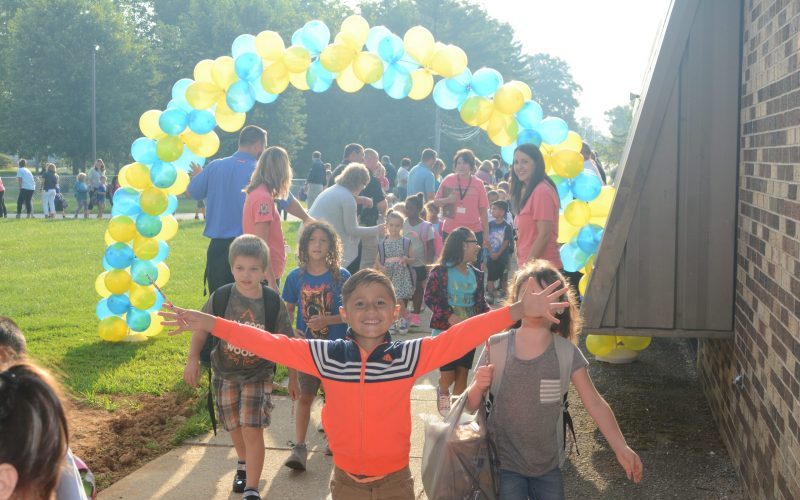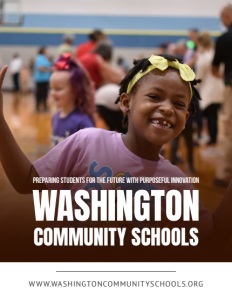Preparing Students for the Future with Purposeful Innovation
Expanding STEM education, modernizing facilities, and strengthening career pathways.
At Washington Community Schools in Indiana, an unwavering belief drives every decision: all children are capable of success, no exceptions. This philosophy, implemented since 2017, has transformed the district’s approach to education, particularly benefiting its diverse student population that includes English language learners and students from varying socioeconomic backgrounds.
“We pride ourselves in being what we call a Kids at Hope School District,” says Superintendent Kevin Frank, alongside Assistant Superintendent Steve Peterson and College and Career Academy Director Matt Riney. “On a scale of one to 10, we ask all our staff – from teachers to custodians, bus drivers, and food service workers – how much they believe all children are capable of success. We want everyone to be a 10.” This commitment is celebrated monthly through their “10’s days” initiative, recognizing staff who embody this mindset.
The district structures its educational framework around four key destinations: college and career, home and family, hobbies and recreation, and community service. “Within these areas, we’re not trying to add anything to teachers’ plates,” Frank explains. “Instead, we tie everything back to the Kids at Hope framework and make those connections for students.”
This approach has proven particularly effective in their elementary schools, where teachers prepare students to think strategically about their futures before entering secondary education. The framework’s success represents a significant shift from 2017 when it was first piloted in an elementary school facing numerous challenges, including high poverty rates and a growing English learner population.
STEM Excellence: From Elementary to High School
Washington Community Schools has built a comprehensive STEM education pathway that starts in kindergarten and extends through high school graduation. Their approach, which integrates Project Lead The Way (PLTW) programs across all grade levels, positions students for success in the rapidly evolving technology sector.
“We’ve taken a district-wide approach to provide a robust STEM experience,” Peterson explains. “At the high school level, we began with PLTW engineering and have expanded to include biomedical sciences and computer science. We’ve built these programs into the K-8 space, with Gateway at the junior high level and Launch in elementary schools.” The district’s strategic location near Crane Naval Base has sparked unique opportunities in microelectronics education.

Their partnership with SCALE K-12, an educational partnership dedicated to preparing students for careers in microelectronic fields, has opened doors to advanced learning experiences. “We work with Purdue University and Indiana University to develop the K-12 microelectronics STEM curriculum,” Peterson notes. “Our teachers receive specialized training at Purdue in microelectronics, bringing cutting-edge knowledge back to our classrooms.” This collaboration has positioned Washington Schools at the forefront of microelectronics education in the American Midwest.
The robotics program exemplifies their hands-on approach to STEM education. “At the high school level, we have two FIRST Robotics Competition teams,” Peterson says. “Our students in grades 5-8 compete in VEX robotics competitions, while K-4 students work with Lego robotics.” These programs culminate in an annual robotics showcase that highlights student achievements across all grade levels.
The school’s innovative approach to STEM education has caught the attention of industry partners, leading to groundbreaking opportunities like a microelectronics apprenticeship program. “These partnerships show the level of opportunities we can provide,” Peterson adds. “You wouldn’t typically expect to find these advanced STEM programs in southern Indiana.”
Bridging Education and Industry
The robotics program at Washington Community Schools exemplifies how innovative education can create direct pathways to industry careers. Their computer science curriculum, featuring advanced placement courses and specialized cybersecurity classes, prepares students for the modern technological workplace.
“Our students discover that mastering technology opens doors to countless opportunities,” Riney says. “I had a student tell me recently that learning computer science made him feel capable of accomplishing anything. It allows our students to see the broader scope of what the world needs and how they can impact society in meaningful ways.”
The school’s robotics program has become a regional powerhouse, hosting one of Indiana’s four major FIRST Robotics Competition events at the Hatchet House. “We’ve become the southwest hub for this competition,” Riney explains. “Teams come from across Indiana and even Michigan. When the community sees the team trailers parked outside our centrally-located school, it creates real excitement about robotics and technology.”
A pioneering credentialing system enhances the program’s educational value. “We’ve established a pathway where students progress from novice to master in different categories – build, coding, electrical wiring, and CAD teams,” Riney says. This system has caught the attention of Vincennes University, leading to a potential partnership that would offer college credits for these credentials. “Students can focus on one area, like wiring, earn college credit, then move on to master other skills throughout their four years.”
The program’s success shines in its graduates’ achievements. “Last year’s robotics seniors have gone on to study engineering or computer science at top universities,” Riney notes. Their innovative approach to robotics education has created a model that combines practical skills with academic advancement, preparing students for both higher education and industry careers.

Planning for the Future: Facility Modernization
Washington Community Schools faces a pivotal moment in its infrastructure development, with six aging buildings straining to accommodate a growing and increasingly diverse student population. The district’s newest facility dates back to the 1970s, an era when modern educational needs, such as spaces for English language learners and advanced technology programs, weren’t part of architectural planning.
“We’re developing a long-range strategic facility plan,” Frank explains. “Our buildings were constructed in the 1950s through 1970s, when the needs of our current student population weren’t considered. We need to modernize our spaces, particularly for our expanding STEM and robotics programs.” The district’s approach to this challenge demonstrates the evolving nature of educational architecture, where traditional classroom designs are being reimagined to support contemporary learning methods.
The planning process has been notably inclusive, engaging dozens of community members in understanding facility needs and demographic forecasts. “We worked with Performance Services, a design-build construction company, to assess our buildings and explore potential concepts,” Frank says. “In the short term, we can issue a tax-neutral bond for smaller projects, including an addition to one elementary school.”
Looking ahead, the district’s leadership has broader ambitions. “The school board and administrative team are engaging the community in developing a shared vision for the next steps,” Frank notes. “We’re looking at how we can meet the needs of all our buildings, especially through the high school level, over the next three to five years.” This systematic approach to facility modernization indicates a growing trend in American education, where schools are adapting their physical spaces to support evolving pedagogical methods and technological requirements.
Beyond Academics: Arts and Athletics Excellence
Washington Community Schools takes immense pride in its extracurricular programs, with facilities that rival larger urban districts. The crown jewel is the Hatchet House, one of the world’s largest high school gymnasiums, hosting not just athletics but a diverse range of student activities.
“The Hatchet House holds about 7,000 fans and regularly hosts state tournaments,” Frank says. “While it’s known for basketball, we’ve transformed it into a multi-purpose venue. Our volleyball team competes there, we hold wrestling matches, and now it’s home to our robotics competitions.” This innovative use of traditional athletic spaces showcases the school’s ability to adapt historic facilities for modern educational needs.
Recent investments have further enhanced the district’s athletic facilities. “We completed a project at Hatchet Hollow, our football complex, with artificial turf, new locker rooms, bleachers, and a concession stand,” Frank notes. “Between the Hatchet House and Hatchet Hollow, we offer some of the best athletic facilities in southern Indiana.”
The performing arts program matches this standard of excellence. “Our band program, led by Branden Burris, transitions from fall marching season to Winter Winds indoor competitions,” Frank explains. “The choir program, under Scott Griffith’s direction, offers unique opportunities including out-of-state performance trips to major cities.” A particular source of community pride is the annual Madrigal Dinner, a Christmas tradition spanning decades.
These robust extracurricular offerings exemplify a holistic approach to education, where athletic and artistic excellence complement academic achievement. The district’s investment in these programs, from upgrading facilities to supporting travel opportunities, support the development of well-rounded students prepared for success in all aspects of life.
Building Tomorrow’s Leaders: A Vision for Growth
At Washington Community Schools, lifelong learning isn’t just an educational philosophy—it’s woven into every aspect of the curriculum. The district’s approach particularly resonates with students from challenging backgrounds, encouraging them to envision and work toward better futures.
“Through our Kids at Hope framework, we help students think about their futures differently,” Frank explains. “For children living in difficult situations, our teachers have appropriate conversations about setting goals. We show them that their current circumstances don’t define their future, but achieving their dreams requires specific steps and dedication.”
The district’s focus on hands-on learning, especially in STEM subjects, helps ignite students’ natural curiosity. “We make learning fun and engaging,” Frank says. “While some learning involves traditional methods like reading, we emphasize hands-on experiences to inspire students to continue learning long after they leave Washington High School.”

Looking ahead, the district has outlined three key priorities. The first involves executing the facilities plan and completing new construction projects. The second focuses on expanding college and career connections, particularly in response to Indiana’s new high school diploma requirements. “We’re developing more structured apprenticeships and internships,” Frank notes. “We’ve already started a teacher apprenticeship program with three students working in our elementary buildings.”
The third initiative centers on developing a dual language immersion program, currently in its second year. “We have bilingual teachers in Spanish and English, and we’re expanding the program through the grade levels,” Frank says. “The program has been so popular we’ve had to create a waiting list.”
These ambitious plans showcase Washington Community Schools’ evolution from a traditional educational institution into a forward-thinking district that prepares students for an increasingly complex world. The blend of innovative programs, hands-on learning experiences, and commitment to individual student success creates a model for modern education in America’s heartland.
AT A GLANCE
Who: Washington Community Schools
What: A forward-thinking public school district focused on STEM, career readiness, and student success
Where: Washington, Indiana
Website: www.washingtoncommunityschools.org
PREFERRED VENDORS/PARTNERS

Founded in 1801 Vincennes University is Indiana’s first college making your degree widely recognized by top employers! Vincennes University develops people and enhances communities through accessible, high-quality educational programs, strategic partnerships, and active engagement.
Vincennes University: www.vinu.edu


